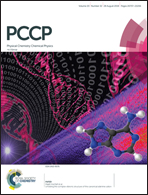Intense UV and visible up-conversion emissions from RE-doped SiO2–BaGdF5 nano-glass-ceramics
Abstract
RE-doped (Yb3+, Er3+ and Tm3+) nano-glass-ceramics (nGCs) comprising BaGdF5 nanocrystals have been developed under thermal treatment of precursor sol–gel glasses. Structural analysis by means of X-ray diffraction patterns, high-resolution transmission electron microscopy images, and energy dispersive X-ray spectroscopy measurements, confirmed the precipitation and distribution of cubic BaGdF5 nanocrystals (around 10 nm in size) in the silica glass matrix. Under near-IR excitation at 980 nm, up-conversion (UC) emissions have been studied as a function of selected dopants, the doping level and the pump power. In addition to the characteristic NIR, vis and UV UC emissions of Er3+ and Tm3+ dopant ions, the studied nGCs present intense UV UC emissions of the host fluoride nanocrystal, Gd3+. It was also observed that the relative Yb3+ content tended to improve the UC emission intensities. Corresponding UC mechanisms and energy transfer processes were analysed in terms of their energy level diagrams and confirmed by transient emission and pump power measurements. Moreover, power dependence analysis revealed that these emissions present saturation effects with the increase of Yb3+ content, even at low pump power. Results suggest that these high-efficiency UC nGCs have potential applications in UV solid state laser materials, solid state lighting and photovoltaics.



 Please wait while we load your content...
Please wait while we load your content...